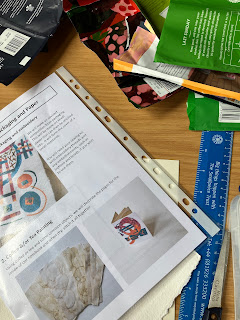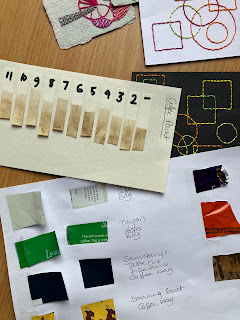Monday, December 1, 2025
Our December Meeting
Tuesday, November 4, 2025
Our November Meeting
Our November meeting was well attended and the hall was soon full of busy stitchers. One stitch club group continued making three dimensional pieces. Nicky had provided plenty of instructions to make a range of 'balls' using pentagons and other shapes. Shapes were cut out of hexiform or pelmet vilene and fabric was basted on. The shapes were then stitched together to create the 3D patchwork shapes using small whipped stitches along the edge. Members who had previously tried English Paper Piecing (EPP)patchwork had a good idea of the process. Anne had been very industrious by continuing from the previous month and had completed a bauble in forest green fabrics, adding embroidery and a beaded hanging loop.
Afternoon speaker - Jacqueline Schultz 'Creative Chapters'
Our next meeting
Wednesday, October 8, 2025
Our October Meeting
AGM
Monday, September 8, 2025
Our September Meeting
However the winning entry was a beautifully stitched passionflower by Celia who was delighted to receive the Ida Barber trophy and a gift voucher for the Viking Loom. The three dimensional embroidery was meticulously worked and the overall design was very harmonious. A worthy winner!
Jo Yeates, Putting the Text into Textiles
Our next meeting
Tuesday, July 8, 2025
Our July Meeting
Jessica Aldred - Traditional Embroidery in a Modern World
Jessica has a wide range of personal interests and uses her considerable skills and enthusiasm to inspire others. She has worked in prisons with FIne Cell Work, teaching prisoners embroidery to help them earn a little money, develop skills and appreciate the mental health benefits of hand work. She also works for a charity providing creative education to learning disabled and autistic adults as well as running her business, House of Heyday. In 2011 Jessica co-authored a book 'Adventures in Needlework' with Emily Peacock who designs contemporary needlepoint.
Jessica brought along a selection of her work, some she had made during her RSN apprenticeship and some to illustrate her more recent work, including a ribbon work kit designed for the V&A Museum as part of their exhibition 'Frida Kahlo: Making Her Self Up'. Clearly she is wonderfully skillful and we admired her exquisite stitching.

























































